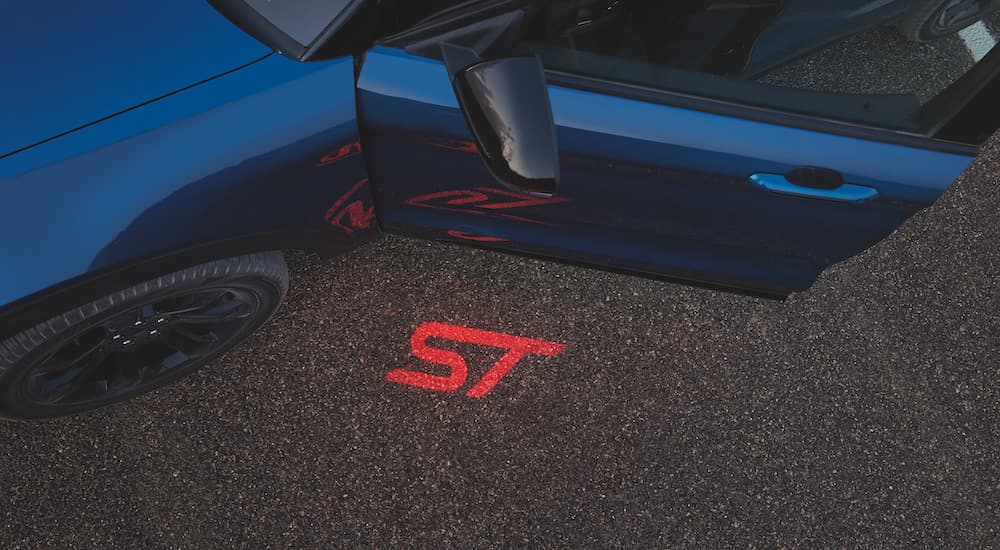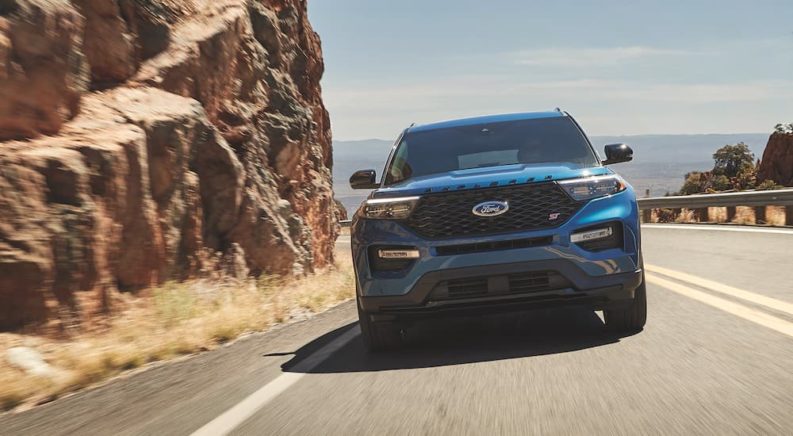Ford has been attempting to capture nearly every segment of the market possible with their diverse lineup of vehicles. You have the Mustang Mach-E for eco-conscious drivers, the Bronco for off-roaders, the Expedition for full-size travel, the Ecosport for the budget-conscious driver, the F-150 for light-duty, F-250 for heavy-duty, and the Maverick for compact utility. Each of these vehicles can also be outfitted in different trim formats that break down into subcategory segments, such as the off-road-oriented Raptor and Tremor iterations of the F-150, or the Escape Hybrid for those who want a compact plug-in. One interesting segment that Ford has targeted—but without making it too obvious—is the crowd of performance enthusiasts using the ST trim for various nameplates. The 2022 Ford Explorer has undergone a few interesting changes for this model year—themed almost entirely around the ST and the new ST-Line trims—which are far more enticing for those who value gusto in their crossover SUVs.
Differences Between the ST-Line and ST
While you might want to rock a sporty 2022 Ford Explorer, you need to be aware that the ST-Line and ST are not exactly the same trims, even though they might seem the same. The ST-Line is an all-new trim added to the Explorer’s line-up for the 2022 model year. It features some of the sport stylings of the ST trim, such as the 20-in wheels; unique badging; performance-themed interior materials with red stitching; and a matching heated, leather-wrapped, sports steering wheel that also has red stitching. However, the ST-Line’s athletic theme doesn’t quite capture all of the sports-oriented performance factors of the ST trim.
The visual aesthetics are nice, but if you wanted more of the oomph that the Explorer has to offer, you’re still better off with the ST. Why? Because the ST-Line comes standard with a 2.3-L EcoBoost 4-cylinder, whereas the ST trim comes standard with the 3.0-L EcoBoost twin-turbocharged V6, which is a completely different beast in terms of performance. The Explorer was introduced to the 3.0-L EcoBoost with the sixth generation, and that has carried over into the 2022 model year line-up.
Another big difference between the ST-Line and the ST trims is the suspension. It may not seem like the biggest thing in the world, but the Explorer ST trim comes with an independent sports-tuned suspension setup for the front and rear1. This includes stiffer bracing and durable components for improved handling at higher speeds, ensuring that you get a more responsive and immediate reaction while on the road2. The ST, in particular, is the only model with this kind of setup among the trim selection, making it a unique entry in Ford’s Explorer offerings.

Rear-Wheel Drive Only for the ST Makes the Difference
The sixth generation of the Ford Explorer was redesigned with a rear-wheel-drive bias with all-wheel and four-wheel drive capabilities. Not every trim off the line was launched with rear-wheel-drive-only options, though. Select sixth-gen Explorer’s trims came with all-wheel, four-wheel, or rear-wheel drive options, but not the ST trim…until now.
The 2022 Ford Explorer ST is the first time the trim is made available with a rear-wheel-drive-only option. So, why is this such a significant feature and why would this matter to performance enthusiasts? Well, it’s all about what kind of performance you want from the Explorer and what you plan to use the vehicle for. Sure, if you want, you can always buy a four-wheel-drive Explorer and then physically remove the front-wheel driveshaft, but then you may run into issues with the viscous coupling and front differential. Alternatively, you could simply buy a rear-wheel-drive version of the vehicle and not have to worry about any potential driveline mechanical failures.
With rear-wheel drive, you have an opportunity to indulge in some exciting off-the-line performance, as well as more control of oversteering compared to front-wheel drive configurations. Most average drivers probably don’t see the benefit of this feature, but it all boils down to what kind of driving you plan on doing, where you plan on driving a 2022 Ford Explorer, and whether or not you want to tune it up for more performance-oriented driving. With the Explorer ST, in particular, it means that you have one of the more powerful trims of the model year lineup—now specifically tuned for high-end, off-the-line acceleration and high-speed handling, but without the $5,000 price hike that comes with the Platinum trim.
Rear-Wheel vs. All-Wheel Tuning Benefits
Some people might be asking, “What’s the big deal about a rear-wheel-drive ST when it’s already available in four-wheel drive?” For performance enthusiasts seeking a speedy midsize SUV, a rear-wheel Explorer ST opens up a lot of unique possibilities. What sort of possibilities? Well, everything from drifting to drag racing to more responsive oversteer. If you don’t care about those things, then the four-wheel-drive configuration is still an option for you.
However, being able to pull off a satisfying burnout in a midsize SUV brings up a whole new level of appreciation for the performance-driven SUV. For that, thank the 400 hp and 415 lb-ft of torque from the twin-turbo EcoBoost V6. That’s not to mention that you can tune and spec the Explorer toward performance handling much easier in rear-wheel drive than in four-wheel drive.
Why? There are fewer components to worry about in tuning the drivetrain. With four-wheel drive, there is more wear and tear on the front tires compared to rear-wheel drive—due to the front and rear wheels propelling the vehicle forward. So if you opt for sports tires or performance tires on your Explorer ST in four-wheel drive format, you will be burning through them at a much quicker rate than in a rear-wheel drive configuration.
When it comes to long-term tuning and maintenance benefits, you also save a lot more with a rear-wheel drive compared to four-wheel drive configurations. You’re only dealing with one driveshaft instead of two, only one differential instead of two, and no worries about having to maintain the upkeep of the transfer case. Overall, you’re just dealing with a lot less maintenance and components with a rear-wheel drive compared to an all-wheel drive. This is especially true if performance is more your deal than off-roading or driving in harsh conditions (sand, unpaved roads, mud, high banks of snow, etc.)
Is a Souped-Up 2022 Ford Explorer ST Rear-Wheel Drive Worth It?
No one can really answer the question of whether a specific trim is worth it until you’re in the trim and driving it yourself. However, if you have a checklist of things you want from a specific kind of brand model you’ve been eyeing, and performance is at the top of that list, then it makes sense why you might want a 2022 Ford Explorer ST—now that it sports rear-wheel drive. Obviously, it’s still a midsize SUV—and not a Hellcat or a Porsche—so you likely won’t be setting new quarter-mile records against a bunch of overpowered V8s. However, you will get some significant gains from an Explorer ST in rear-wheel drive compared to the previous generation’s front-wheel drive models.
The benefits of having a police interceptor-quality powertrain attached to the vehicle make a significant difference—and certainly give those who crave power from their vehicles something to really sink their feet into, on the road or the track. The performance capabilities and tuning possibilities of the 2022 Ford Explorer ST with rear-wheel drive make this trim a winner against all other options. If performance was at the top of your priority list for an SUV, this model is well worth a test drive.





